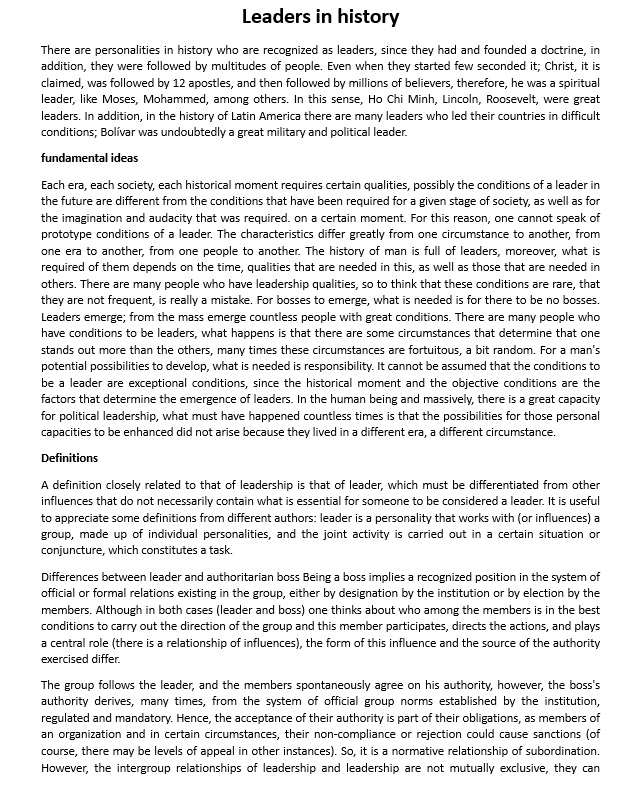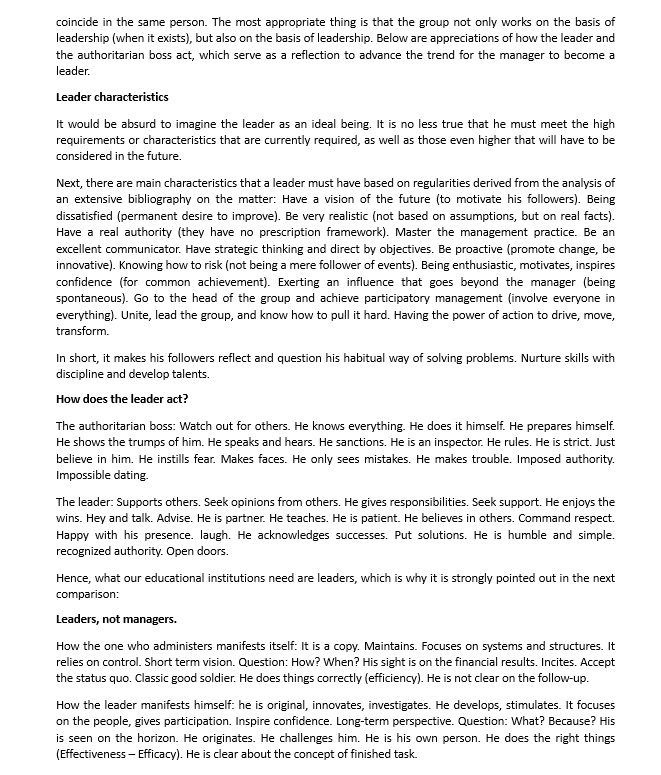Answered step by step
Verified Expert Solution
Question
1 Approved Answer
Based on the following lecture, can you help with a critical analysis, based on the next reading? Please, answer the questions at the end. What
Based on the following lecture, can you help with a critical analysis, based on the next reading? Please, answer the questions at the end.


- What is the main theme of the above reading?
- Write a brief summary of the content of the reading.
- What is the argument of the authors of the previous reading? What do they want to show us in the reading?
- What is the prevailing point of view on it?
- What is transactional leadership and what have been its greatest exponents? Include the ones that are in the previous lecture.
Five to six full sentences per each question. Thank you.
Leaders in history There are personalities in history who are recognized as leaders, since they had and founded a doctrine, in addition, they were followed by multitudes of people. Even when they started few seconded it; Christ, it is claimed, was followed by 12 apostles, and then followed by millions of believers, therefore, he was a spiritual leader, like Moses, Mohammed, among others. In this sense, Ho Chi Minh, Lincoln, Roosevelt, were great leaders. In addition, in the history of Latin America there are many leaders who led their countries in difficult conditions; Bolivar was undoubtedly a great military and political leader. fundamental ideas Each era, each society, each historical moment requires certain qualities, possibly the conditions of a leader in the future are different from the conditions that have been required for a given stage of society, as well as for the imagination and audacity that was required. on a certain moment. For this reason, one cannot speak of prototype conditions of a leader. The characteristics differ greatly from one circumstance to another, from one era to another, from one people to another. The history of man is full of leaders, moreover, what is required of them depends on the time, qualities that are needed in this, as well as those that are needed in others. There are many people who have leadership qualities, so to think that these conditions are rare, that they are not frequent, is really a mistake. For bosses to emerge, what is needed is for there to be no bosses. Leaders emerge; from the mass emerge countless people with great conditions. There are many people who have conditions to be leaders, what happens is that there are some circumstances that determine that one stands out more than the others, many times these circumstances are fortuitous, a bit random. For a man's potential possibilities to develop, what is needed is responsibility. It cannot be assumed that the conditions to be a leader are exceptional conditions, since the historical moment and the objective conditions are the factors that determine the emergence of leaders. In the human being and massively, there is a great capacity for political leadership, what must have happened countless times is that the possibilities for those personal capacities to be enhanced did not arise because they lived in a different era, a different circumstance. Definitions A definition closely related to that of leadership is that of leader, which must be differentiated from other influences that do not necessarily contain what is essential for someone to be considered a leader. It is useful to appreciate some definitions from different authors: leader is a personality that works with (or influences) a group, made up of individual personalities, and the joint activity is carried out in a certain situation or conjuncture, which constitutes a task. Differences between leader and authoritarian boss Being a boss implies a recognized position in the system of official or formal relations existing in the group, either by designation by the institution or by election by the members. Although in both cases (leader and boss) one thinks about who among the members is in the best conditions to carry out the direction of the group and this member participates, directs the actions, and plays a central role (there is a relationship of influences), the form of this influence and the source of the authority exercised differ. The group follows the leader, and the members spontaneously agree on his authority, however, the boss's authority derives, many times, from the system of official group norms established by the institution, regulated and mandatory. Hence, the acceptance of their authority is part of their obligations, as members of an organization and in certain circumstances, their non-compliance or rejection could cause sanctions (of course, there may be levels of appeal in other instances). So, it is a normative relationship of subordination. However, the intergroup relationships of leadership and leadership are not mutually exclusive, they can coincide in the same person. The most appropriate thing is that the group not only works on the basis of leadership (when it exists), but also on the basis of leadership. Below are appreciations of how the leader and the authoritarian boss act, which serve as a reflection to advance the trend for the manager to become a leader. Leader characteristics It would be absurd to imagine the leader as an ideal being. It is no less true that he must meet the high requirements or characteristics that are currently required, as well as those even higher that will have to be considered in the future. Next, there are main characteristics that a leader must have based on regularities derived from the analysis of an extensive bibliography on the matter: Have a vision of the future (to motivate his followers). Being dissatisfied (permanent desire to improve). Be very realistic (not based on assumptions, but on real facts). Have a real authority (they have no prescription framework). Master the management practice. Be an excellent communicator. Have strategic thinking and direct by objectives. Be proactive (promote change, be innovative). Knowing how to risk (not being a mere follower of events). Being enthusiastic, motivates, inspires confidence (for common achievement). Exerting an influence that goes beyond the manager (being spontaneous). Go to the head of the group and achieve participatory management (involve everyone in everything). Unite, lead the group, and know how to pull it hard. Having the power of action to drive, move, transform. In short, it makes his followers reflect and question his habitual way of solving problems. Nurture skills with discipline and develop talents. How does the leader act? The authoritarian boss: Watch out for others. He knows everything. He does it himself. He prepares himself. He shows the trumps of him. He speaks and hears. He sanctions. He is an inspector. He rules. He is strict. Just believe in him. He instills fear. Makes faces. He only sees mistakes. He makes trouble. Imposed authority. Impossible dating. The leader: Supports others. Seek opinions from others. He gives responsibilities. Seek support. He enjoys the wins. Hey and talk. Advise. He is partner. He teaches. He is patient. He believes in others. Command respect. Happy with his presence. laugh. He acknowledges successes. Put solutions. He is humble and simple. recognized authority. Open doors. Hence, what our educational institutions need are leaders, which is why it is strongly pointed out in the next comparison: Leaders, not managers. How the one who administers manifests itself: It is a copy. Maintains. Focuses on systems and structures. It relies on control. Short term vision. Question: How? When? His sight is on the financial results. Incites. Accept the status quo. Classic good soldier. He does things correctly (efficiency). He is not clear on the follow-up. How the leader manifests himself: he is original, innovates, investigates. He develops, stimulates. It focuses on the people, gives participation. Inspire confidence. Long-term perspective. Question: What? Because? His is seen on the horizon. He originates. He challenges him. He is his own person. He does the right things (Effectiveness - Efficacy). He is clear about the concept of finished taskStep by Step Solution
There are 3 Steps involved in it
Step: 1

Get Instant Access to Expert-Tailored Solutions
See step-by-step solutions with expert insights and AI powered tools for academic success
Step: 2

Step: 3

Ace Your Homework with AI
Get the answers you need in no time with our AI-driven, step-by-step assistance
Get Started


